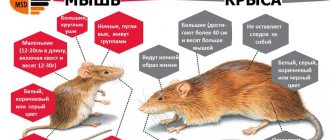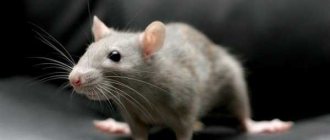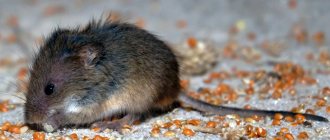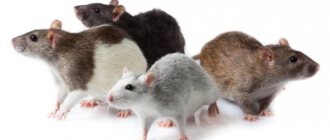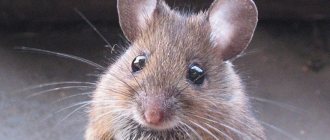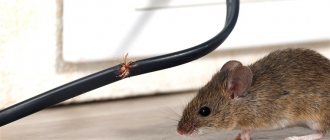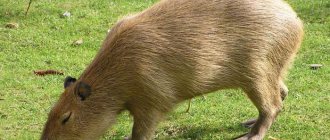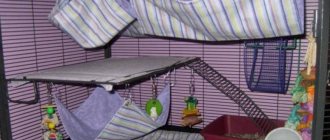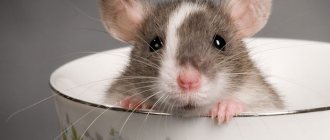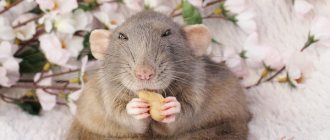There is practically not a single person who has not encountered mice or their cousins, rats, at least once in their life. Night rattles and rustling that prevent you from falling asleep, spoiled food, chewed furniture - all this indicates the appearance of unexpected guests in your home.
Some tirelessly fight with them, showing who is boss, while others, on the contrary, deliberately bring them into their homes, taming them and making them their favorites.
However, one should not ignore the fact that both mice and rats are the source of all sorts of dangerous diseases . Therefore, it is imperative to fight them. In order to choose the right method for getting rid of rodents, you need to know what their differences are.
And if in adults the difference is obvious - rats are much larger than mice, then what little rats and mice look like remains a question for many of us.
What do rats and mice have in common?
These mammals belong to the order of rodents of the mouse family. There are other common features. Because of them, these two species are often confused.
Mice and rats: general features of life
Both of them belong to cosmopolitan species. That is, these rodents inhabit all corners of the Earth except Antarctica and the Far North, and they are not found high in the mountains.
These rodents are considered synanthropic, that is, associated with humans. Wild subspecies live in human homes, utility rooms or those intended for keeping pets. Although in warm regions they can live far from human habitation.
Rodents are animals with a nocturnal and twilight lifestyle. They are most active at sunset. However, when kept in captivity, animals adapt to the rhythm of life of the owner, get used to staying awake in the light and reducing activity during human rest.
These types of rodents are very active. They climb, run, jump and swim beautifully. Possessing high plasticity of the body, the animals can “leak” into very small crevices.
In nature, mice prefer to live in colonies in which they maintain a hierarchy. Adult males can start fights among themselves. In families, aggression sometimes spreads to older offspring, which the parents expel from their territory.
Rodents are clean creatures. They keep their homes clean and tidy. The droppings and piles of dust held together by urine that they leave while moving are special marks for determining the route.
Both types of rodents not only live in nature, but also take root in captivity and are easily tamed. Today, breeders, which many fanciers are happy to keep as companion animals.
Similarity in appearance
The mouse really looks like a smaller copy of a rat:
- The house mouse and are covered with horny scales and sparse short hairs. Only the black rat stands out here. Her tail is covered with thick hair.
- Both species have round black eyes (in albinos they are red or dark ruby).
- The main characteristics of these two types of rodents are long, sharp incisors that grow throughout their lives and the absence of fangs. With their teeth, animals can gnaw through very hard materials, even concrete.
Who-who lives in our house?
It is clear that it is unrealistic to conduct a comparative assessment of absolutely all species of mice and rats living on the planet in one material, so we should focus only on frequently occurring individuals in our climate zone.
Populated areas are mainly inhabited by gray rats and house mice; sometimes voles come to visit, but they are not particularly different from “domuses”. There are also black Sinanthropus rats, but they can only be found on the Pacific coast and in Eastern Siberia. Their second name is ship pests, since pests are regulars at seaports and water vessels.
What is the difference between a rat and a mouse
Despite the similarities between these rodents, they differ greatly from each other:
The main differences are due to the different number of chromosomes. In rats there are 22 of them, and in mice 20. Therefore, it is impossible to cross these mammals in order to produce offspring. Decorative rats reach 30 centimeters in length excluding the tail. Mice do not grow more than 9 and a half centimeters. Large rodents weigh up to 650 grams. A mouse cannot be heavier than 30 grams. Despite the fact that the number of newborn rat and mouse pups per female varies from 5 to 12, the number of nipples in rodents varies. A rat has 12 of them, while a mouse has fewer nipples - only 10. Due to their fast metabolism, the activity of mice differs from rats in being polyphasic. The animal falls asleep 15-20 times per day. Each activity phase lasts from 25 minutes to one and a half hours. The rat lives more “slowly”: it sleeps once a day if it is not disturbed. There is a difference between them in nutrition. Although both of these species are omnivores and can attack and eat other living creatures, the rat’s predatory instinct is more developed. Mice are seed eaters. Predatory instincts appear only when absolutely necessary, which is why they are even considered vegetarians.
Rodent hunters
A rat differs from a mouse in being more aggressive. When danger approaches, they show miracles of courage and can even attack a person in defense. In nature, rats often hunt in packs. Animals in groups can even attack mammals larger than themselves.
Mice prefer to hunt alone. Therefore, only insects and smaller animals become their victims. These animals are shy and extremely careful.
Due to such character traits, these animals are natural enemies. Large rodents attack small ones, kill them, and may even eat them. Therefore, the instinct of self-preservation dictates that mice beware of their larger relatives. Smelling the smell of a rat, small rodents leave their habitat.
For the same reason, individuals of these two species cannot be kept together. It is not even recommended to place cages with them in the same room.
Comparison of rodent intelligence
Rats are smarter and smarter than their smaller counterparts. Catching a wild specimen is a troublesome task. They are careful, attentive, cunning. If the loser suddenly falls into a trap, she lets the rest of the colony know about the danger. Never again will any animal appear here.
There are many stories about how these clever thieves opened bottles of wine, closed with plastic caps, one of them put the tail into the neck, pulled it out, and others licked the delicacy from it.
Or how rodents, climbing over a wide crevice, stuck together in a path, biting the tail of the animal in front with their teeth. Using such a living bridge, the entire colony easily crossed the obstacle.
Companion rats, living next to humans, also show their remarkable abilities. They are easy to train, respond to names, and even come up with their own games, inviting the owner to join.
There are no similar stories about mice. However, these sweetest creatures can give their owners a lot of pleasant moments of communication. They also become attached to a person and touch those who watch their lives with their habits.
Who grows faster: a mouse or a rat?
The metabolism of mice is higher than that of rats, so their lifespan is shorter. The average lifespan of small rodents when kept at home is 1.5-2 years, while their large relatives live up to 2-3 years.
Rats and mice grow the same way. At the age of 1-1.5 months, young rodents are capable of reproducing their own offspring.
Rat tails are longer than mice's. They are equal in size to 70-110% of the body. Mouse tails are shorter. They can reach no more than 60% of the body; the tails of large rodents are thicker than those of mice and more powerful (with the exception of the tailless rat); rats' faces are sharper and more elongated. Mouse heads are rounder and less pointed; The body of small rodents is more round. The animals rarely straighten up, preferring to sit huddled together in a ball. And their species relatives can rest, lying on their tummy, with their hind legs stretched out, like cats; mouse fur is soft and silky, while rat hair resembles coarse hair; The hearing organs of rodents are structured differently. Mouse ears are thinner and rounded. They resemble petals rolled up into a ball. Rat ears are thicker, sharper, and not curled.
Gray rat: habitat
In nature, these rodents settle only where there are sources of water, without which they cannot survive even three days. They prefer lowlands overgrown with vegetation, but can also climb mountains. They don't bother people at all. Only rats that live near humans are harmful. Some are permanent tenants, others are temporary, leaving in the spring to live freely and returning in the fall. They live in boiler rooms, basements, barns, and can live in high-rise buildings, but they rarely rise above the 9-10th floor.
In cities, rats have chosen sewer systems and subways, port docks and store warehouses. In villages, they live on livestock farms, poultry houses, and fruit and vegetable processing factories. One rat family controls a territory of up to 2 thousand m2, which all its members regularly mark with urine. In case of food shortage, rodents can expand the boundaries of their kingdom.
Animal behavior
Mice in the house crawl out of their holes only when there is complete silence. If a slight rustle occurs, they try to move away unnoticed as much as possible. When a house is found, the whole family moves in there without first examining the territory. Due to the more primitive structure of the brain, they fall into simple mousetraps, and in many cases cannot recognize the poison used against them by humans. They move directly.
Rats always search the area first. Seeing a person, they are in no hurry to hide, they think over a safe route of retreat, and not finding him, they attack the enemy, biting the neck, and if such a bite is impossible, the limbs. The more adults die, the more babies are born to the remaining ones.
If you fail to catch a rodent, you should pay attention to the traces it leaves. The paw prints left by rats are quite clear and rare because they move by jumping
As for the tracks left by mice, they are more frequent. A careful inspection of the lower part of the walls will help you identify the uninvited guest.
When rats move, they press against the surface, leaving abrasions. Mice are more careful in this regard, so there are no characteristic marks left behind. Pasyuk is a rather aggressive creature that can attack a person if it feels that his life is in danger, which cannot be said about the practically harmless mouse, which often runs away at the sight of a person.
The house mouse is one of the most common species of mammals, whose life is closely related to humans.
In terms of mental development, a rat is significantly superior to a mouse. Some people even compare large rodents to dogs and cats. They are more careful and discerning. When choosing a new place to settle, Pasyuks first explore the territory to make sure it is safe. Because of this quality, it is quite difficult to get rid of rats using various poisons.
We suggest you read: How to get rid of rats in a chicken coop forever
Intelligence
The mental abilities of these two representatives of the mouse family are also very different. According to scientists, rats are intellectually developed creatures.
- Firstly, they will not settle in places that are potentially dangerous for them.
- Secondly, they always examine the future home and assess the situation.
- Thirdly, they create entire communities with their own hierarchy and laws.
Norushki are more reckless in this regard, and therefore it is much easier to fight them, since you can easily deceive or outwit.
Intelligence of Rats and Mice: Key Differences
Rats have more developed intelligence than mice (this also applies to domesticated rats and mice). But this does not mean at all that a mouse is a bad pet. Decorative rats are very smart animals that quickly make contact, and they also quickly become attached to their owner. They are trainable and can express their affection and love. In addition, the decorative domesticated rat knows and responds to its name when it is called to itself, especially if the owner offers some kind of delicacy or fun activity.
Essentially, the intelligence of a pet rat can be compared to that of other pets (cats and dogs). Rats are sociable animals that respond well to people, as evidenced by their love of games. According to many owners of pet rodents, the latter can even come up with their own entertainment and games, subsequently willingly demonstrating them to their owners, inviting them to join in the fun.
Life cycle
On average, ordinary gray rats live about 3-5 years. Larger black individuals are 4-6 years old. The lifespan of mice is 3 years. Both are extremely fertile, and the family is growing by leaps and bounds.
Pregnancy in rats proceeds very quickly - about 24 days, and in mice about 18. There are more than 10 individuals in one litter. There may be 7-10 cases of pregnancy per year. So they gain numbers with amazing speed, especially in favorable conditions: a good climate and constant access to food.
Varieties of pet animals
Any species of rat differs in certain signs and characteristics: color, markings, body type and coat type. Therefore, rats are classified differently, and among them you can see completely different and unusual species. And many colors and types of coat were borrowed from dogs and cats.
After identifying the pasyuks, scientists still had a lot of time to search for other rats and breed new ones. Therefore, today there are many different colors, and eye color wins the hearts of many pet rodent lovers. The most unusual colors are considered to be the Himalayan and Siamese.
The eyes of rats can also surprise you, as can their color. Eye color can be: red, black, ruby. The most interesting are the different eyes, for example, one is black and the other is red. Such rats are not so rare. An interesting fact is that owners of black eyes see much better than their relatives with other eye colors.
A striking example of borrowing names from cats are sphinx rats, but it is rare that some animals are born with a color very close to that of a cat. All sources mention only 2 rats born with a tricolor color. The first was named Solaris, she was born in Alaska in 2002, and the second appeared in 2006 and was named Dusty Mouse.
LITTLE MOUSE IN THE FOOD CHAIN
The main food of the baby mouse is the seeds of various herbs, primarily cereals and legumes, tree fruits and grains of cultivated plants. In summer, animals also readily eat small insects such as butterflies, moths and grasshoppers, and their larvae.
NUTRITION OF THE BABY MOUSE
CHINA MEADOW
In the second half of June, in sparse mixed and birch forests, on forest edges and slopes, and in steppe meadows, the herbaceous perennial blooms - meadow chin. On tall, up to 1 m, thin stems, among many small leaves and tendrils, clusters of bright yellow moth flowers light up. Soon they will turn into beans. This plant from the legume family is loved by sheep, horses, and geese. Nina meadow, like many other legumes, is very nutritious: it contains a lot of ascorbic acid, carotene and vitamin P, and microelements. And, despite the bitter taste, the little mouse gladly includes it in its diet.
OATS
The baby mouse's obligatory dish is grains of cultivated cereals. For example, oats. The fruits of this plant are distinguished by the optimal percentage of carbohydrates, proteins, fats and B complex vitamins. Oats contain the protein necessary for the body to grow and repair tissues. Soluble fiber lowers blood cholesterol levels, protecting the cardiovascular system. Vitamins and minerals are involved in important metabolic processes in the body. It is no coincidence that people use oats as a dietary product and include them in the diet of those recovering. The mouse, although it does not know about the chemical composition of the cereal, appreciates it, perhaps, more than a person.
ENEMIES OF LITTLE MICE
LASKA
This smallest representative of mustelids is a formidable enemy for the tiny mouse. Agile and agile, the weasel runs quickly and crawls through the narrowest cracks and holes. This bloodthirsty animal sometimes stores up to 30 voles and mice in reserve! There is no escape for small rodents either on the surface or in the burrow from this predator. She makes several holes in bird eggs and sucks out the contents. 6 In search of food, the hardy animal runs up to 2 km per day. The weasel moves skillfully under the snow and swims well. This animal is distinguished by its courage. Thus, the weasel desperately defends its nest, no matter how great the danger. Sometimes a weasel even copes with a bird of prey that attacks it itself, gnawing its throat in flight.
COMMON FOX
Mice and voles make up about three-quarters of this predator's diet. There is even a special term for fox hunting for small rodents - mouse hunting. The fox's ability to change its diet depending on its habitat is amazing. In the southern regions of Europe it eats reptiles, in the Far East, near rivers, salmon fish, and near the seashore, sea debris (from mollusks to large mammals). In the taiga it attacks large birds and even young ungulates. She deftly grabs beetles flying by, and after the rain she collects earthworms. Be sure to add fruits and berries to meat foods. But the hare becomes prey only during the period of lack of food; the fox very rarely chases after it.
GRAY OWL
This is one of the most common owls in temperate latitudes. She prefers to forage in forest clearings, forest edges and floodplain habitats, primarily at twilight and at night. The main food of owls is small mammals, which the owl detects with the help of exceptionally sensitive hearing. Moreover, in absolute darkness, the error when throwing for prey is no more than one degree.
House mouse - appearance and behavior
The house mouse is the most common rodent living in human housing. Over many years of coexistence, its diet has changed significantly; the animal switched from cereals and nuts to plant and animal products that people eat. In the summer, mice can live in the fields, picking up grains, but by mid-autumn they will certainly move closer to humans and a warm home.
The intelligence of house mice is quite low, they are also not very careful, so they easily fall into even the simplest mousetraps. The population of these rodents is maintained only due to their rapid reproduction - females give birth to offspring every month, up to 100 mice per year
Their body length is 7-8 cm, in rare cases with good nutrition - up to 10 cm, weight - 25-40 grams. Thanks to such miniature dimensions, the mouse is able to squeeze through even a centimeter gap.
Interestingly, the colors of mice depend on the geographic location of their residence. In southern and central Russia, rodents with light silvery skin are common; in Siberia, their fur is more brown than gray. The line between colors is becoming increasingly blurred over time - animals travel on all types of transport, so sometimes you can see an animal of an unusual color.
Life expectancy difference
Mice live very little in the wild and at home - their average lifespan is 1.5–2 years. Despite this, the colonies of these animals grow quite quickly, since rodents are able to give birth to offspring already at the age of 8–9 weeks. Moreover, additions to the family can occur up to 10 times a year.
You will be interested to know how many years decorative house mice live.
The lifespan of rats is longer - up to 3 years. They also become “parents” quite early, reproducing up to 12 members of the offspring at a time.
External differences
The main signs of differences between rats and mice can be observed in external characteristics. First of all, they are clearly visible in the mass of animals, as well as in the structure of the body. Based on them, you can easily determine which representative of the rodent family is in front of you.
Dimensions
The most significant difference between rodents is determined by size. Rats have significantly larger dimensions and a stocky body. The length of an adult can reach 30 cm, not counting the tail. At the same time, weight indicators fluctuate between 600–700 g. A mouse is a smaller rodent. It rarely grows more than 10 cm in length, and its weight does not exceed 30 g.
Tail
It is also not difficult to distinguish animals by the characteristics of the tail. In rats, it looks more massive, thick, has an impressive length, which is sometimes not inferior to the length of the main body, and sometimes exceeds it, reaching up to 35 cm. The tail is bald or bristly, depending on the species. In small rodents, the length of the tail ranges from 4 to 6 cm, almost all over it is covered with small hairs.
Find out also what to feed and how to care for a decorative rat.
Head
The shape of the head of a rat and a mouse also has significant differences. The former has a more elongated, pointed muzzle. The organs of vision are poorly developed. Small black or red eyes are deep-set and have a small viewing angle, so the animals have to constantly turn their heads to examine their surroundings. It is interesting that they see it in gray tones, and red objects are transformed into black.
In mice, the shape of the head is more rounded, flattened, and its size is much smaller. But the eyes, compared to the size of the muzzle, are large, convex, and expressive. The animal has developed farsightedness.
Important! Both types of rodents have teeth that grow throughout their lives, so they need to be given hard objects to chew on that can grind down their incisors.
Paws
There are practically no calluses on the rat's paws, which are necessary for climbing. But there are movable fingers with sharp claws. Thanks to this property, rodents can move freely through trees. Sometimes they make homes for themselves in abandoned hollows. The excellent muscularity of the paws allows rodents to jump long distances. Another advantage of the limbs is the presence of membranes between the fingers, which are similar in appearance to folds of skin.
They make rats excellent swimmers, capable of obtaining food in a body of water. When moving along a horizontal surface, the paws of rodents are widely spread. If you manage to examine the footprint, you will notice that the angle between the outer phalanges is about 180°. Since the predator often moves by jumping, the distance between the tracks can also be impressive.
You may find it useful to know what types of domestic rodents there are.
The legs of mice are short. Each of them has 5 tenacious fingers, so these small rodents are able to move through trees. However, their limbs are not as powerful as those of rats. They move mainly in mincing steps, with the toes spread minimally, and the distance between the tracks is about 1 cm.
Wool
Mice have softer, more delicate fur. In nature, its predominant color is brownish-gray or ash-gray, but it can vary depending on the environment. For example, desert mice have a yellow-sandy coat color, and among decorative species there are white, black, gray-blue, and variegated tones.
Did you know? Mice keep their homes clean and tidy, and with droppings they mark routes to food sources.
Rats have thicker, longer, and coarser fur. The most common colors are gray and dark brown. In individuals bred as decorative domesticated animals, many other shades are found: white, gray, reddish, spotted, etc.
Ears
The rat's ears are straight, even, pointed towards the top.] Hearing is very well developed - the animal perceives sounds with a frequency of up to 40 kHz, while humans - up to 20 kHz. In mice, this figure is even higher - animals perceive sounds with a frequency of up to 100 kHz, although the hearing organs themselves are small, rounded, rolled up.
Characteristics of the rat
Rats are the most common animals on Earth. The body length of an adult varies from 7 to 35 centimeters (larger giants are found), weight - from 30 to 500 grams. The body is elongated, oval in shape, the muzzle is pointed. The eyes and ears are small. The length of the tail sometimes exceeds the length of the animal's body. The tail itself is bare, scaly, with small hairs. There are individuals with a short tail and no tail at all. The color is usually gray, but there are rats of other colors - white, black, beige, etc.
They run fast, reach speeds of up to 10 km/h, and overcome obstacles more than a meter high. They swim and dive well and can live in water for three days. Rats settle in dark secluded corners and can build a nest at heights, as they move well along steep surfaces. Omnivores, the main diet consists of plants, insects, small rodents, and cereals. They do not tolerate hunger well and therefore cannibal rats are often found.
Rats have poor eyesight and a very small viewing angle, which forces them to constantly move their heads, but they also have excellent hearing.
They are nocturnal, not cowardly, and in case of danger they can attack a person. Before moving into a person’s home, they examine it for some time.
Physical differences between mice and rats
The main difference between mice and rats is body size; the body length of an ordinary adult mouse is 7 centimeters, and a rat is 25. Accordingly, the weight of the animals is radically different.
The muzzle and body of the rat are more elongated and sharp, while the body of the mouse is rounded, with a slightly flattened muzzle. Mice have large eyes and protruding ears, while rats have small eyes and ears pressed to the head. There are also differences in fur; mice have soft and silky fur, while rats have coarse hair.
The rat's body is more muscular, its paws are webbed, due to which it moves well in the water. The tail is longer and thicker than a mouse's, with many rings. It is difficult to distinguish a baby rat from an adult mouse, since they are approximately the same in size and the tail of the former is still quite short.
The average life expectancy of rodents also differs. Although the books indicate that both rats and mice live on average 2-3 years, in fact mice are most susceptible to weather conditions, diseases, even mild chemicals that do not cause any harm to rats. Many members of the mouse flock die before the age of one year, unable to survive the harsh living conditions. Rats are much more resilient in this regard.
Differences in nutrition
In the warm spring-summer period in the natural environment, the mouse prefers to eat plant seeds and cereals. Field animals feast on wheat, buckwheat, and oats. Rodents living in forests prefer hazel nuts, acorns, and can even feed on small insects. Near reservoirs they find roots and stems of plants, berries, and larvae.
With the arrival of autumn cold weather, the mouse begins to actively look for warm places to eat, moving closer to humans. Penetrating into a home, it becomes omnivorous. In addition to any edible food, she will not disdain such products as soap or candles. Animals cause particular harm to stocks of vegetables stored in the basement, to cereals in bags, they can chew wires, and inhabit shelves with linen and clothes.
Important! Ornamental rodents should not be given raw meat, lard and smoked meats.
Rats bring even more trouble. These rodents are capable of causing damage to anything in their path, including wires and structures. Everything that humans eat suits them perfectly. Under natural conditions, rats need food high in protein, feeding on fish, amphibians, and insectivores. By nature they are predators, they destroy bird nests, and can eat small rodents, including mice.
At home, a large rodent eats any food products and waste, and does not disdain feed intended for livestock and poultry. The rat does not store supplies, but without food it dies quite quickly, after 3–4 days. Her diet must contain water or food containing a lot of moisture. Without receiving it, the rats die within a few days. As for domesticated ornamental species of rodents, it is recommended to feed them with grain feed and vegetables. Protein foods are served in the form of boiled chicken, egg whites, and cottage cheese.
Read how to properly bathe a rat at home.
Lifestyle
Mice and rats prefer to be nocturnal. The owner of an apartment or house quickly discovers the animals after dark. They scratch loudly, make unpleasant sounds, and gnaw on surrounding objects.
Pasyuk is a natural mouse enemy. She destroys the norushkas and expels them from the inhabited territory. If a mouse smells the scent of a bee, it will prefer to move to a safer place.
Interesting!
There are people who deliberately keep pet rats. In this way they try to get rid of the mouse invasion.
If you don’t know how to distinguish rats from mice by appearance, take a closer look at what food predominates in their diet:
- Pasyuki love to live in landfills. They are omnivores and do not hesitate to feast on leftovers from the human table. In the absence of food, rats begin hunting for their fellows.
- The mouse loves to chew seeds and cereals. Its teeth are not capable of damaging concrete or brick, but they can wear down paper, soft wood, and leather goods.
The behavior of rats is aggressive. If there is danger, . The animals are capable of attacking in a pack. Mice are shy. They try not to be seen by people and flee.
Types of mice
There are about 300 of their representatives. Some of them are decorative and are specially selected for home maintenance. These, for example, include tiny mice with a body length of about 7 cm. These rodents are brightly colored. At the same time, the juveniles have brownish, dull fur. After the first molt occurs, the rodents become bright red. They are kept in spacious cages and must be fed invertebrates, grains and greens.
The largest mouse is the Asia Minor mouse, reaching 13 cm. It is mainly found in Asia, Georgia in mountainous areas.
In the central regions, the field mouse is mainly widespread, which rarely settles in human buildings. Her tail is a quarter less than her body length. The color is reddish-brown on the sides, with a black stripe running down the center of the back. However, coloration for rodents is not one of the main characteristics by which they can be distinguished, since it differs somewhat by region, and due to their migration, it can change beyond recognition.
The most common taxonomic unit that inhabits homes is the house mouse. This type of mouse is characterized by the fact that their length reaches 10 cm, the tail can be the same length as the body length, or be half of it. During its existence with humans, it has adapted to its food, eating plant and partly animal products that humans consume. In the summer they can go to the fields, where they feed on grain, and with the arrival of autumn they move to human habitation.
Also, wood mice can settle in houses during autumn migration.
When can you give?
The minimum age at which a small rat can be transferred to other owners is 5-6 weeks. At this age, he is already completely independent, has all the necessary life skills. Until this time, the animal must stay with its mother as part of the brood, since under these conditions it will have to learn everything it will need in adult life, for example, to arrange a home and build a nest.
There is also no point in delaying the transfer of the animal to another owner. Firstly, even if you are not going to give away the babies, at the age of 5-6 weeks you will need, at a minimum, to seat the females and males in different houses, since they will already be ready for mating. Secondly, the younger the animal, the easier it gets used to its new owners. Relocation to a new home occurs with virtually no fear or stress for the animal.
Did you know? During a stressful situation, a baby rat is capable of producing a sound equal in volume to a working jackhammer, but due to the ultra-high frequency, a person cannot hear it.
How are rodents harmful?
Rats are pests. The very rapid reproduction of rats causes serious damage to both farmers and villagers, and residents of the metropolis. Here's why rats are dangerous in the country:
- carry severe infectious diseases: plague, tuberculosis, brucellosis, leprosy, rabies, typhus, hepatitis, etc.;
- these animals destroy food products in warehouses and factories;
- eat feed from farm animals and birds;
- chew floors and walls of premises;
- damage electrical cables and various devices;
- contaminate food products with helminths and salmonella.
Rats adapt well to any conditions, and they are very tenacious. These animals cause a lot of inconvenience to people and carry dangerous diseases, so it is necessary to get rid of them without pity in all possible ways.
Damage that rodents can cause
Both rats and mice cause many problems for the home owner.
- The first problem is damaged things, furniture, food, damaged electrical appliances due to chewed wires, an unpleasant odor, and droppings.
- The second problem is possible attacks by rats on household members.
- The third problem is the high birth rate of rodents, which makes them difficult to get rid of.
- And the fourth, most serious problem associated with the presence of rodents in the house is the infections that they carry. They are carriers of many infections, such as plague, tuberculosis, hepatitis, rabies and many others. When an animal bites, it can infect a person.
No owner will be happy with such a neighborhood. As soon as traces of rodents in the house are noticed, you must immediately begin an active fight against them, otherwise in a couple of months there will be many more of them and it will be very difficult to remove them from the house.
How to get rid of rodents
It may be difficult to get rid of rats and mice, but it is possible and necessary! There are traditional ways to control rodents:
If you are unable to get rid of the rodents on your own, then you should resort to poison. You can call a special service that deals with rodent baiting, or you can purchase chemicals yourself at a hardware store and disinfect your home.
Both mice and rats are very resilient animals that have lived side by side with humans since ancient times. They cause a lot of trouble for home owners, and it is important to get rid of them at the very beginning of their move in, since over time their flock will increase significantly.
What is the difference between a baby rat and a mouse?
Rodent breeders claim that it is not difficult to distinguish a mouse from a baby rat. Babies are different sizes and look different. But for a person who does not see newborn animals every day, it can be difficult to figure out which species is in front of him.
Baby mice and baby rats have the following differences:
- Mice have a pointed muzzle. Baby rats have a blunt nose.
- The mice's ears are large and round. Rats have a triangular ear that is pressed to the skull.
- The tail of a newborn minnow is long, but in rat pups it is thick and short.
- Small mice do not have skin folds between their fingers.
A baby rat reaches the size of an adult mouse in a month. At this point, it becomes difficult for many to distinguish a mouse from a baby rat. If the animals cannot be seen closely, then you need to navigate along the ground they leave:
- The print of mouse limbs does not show webbing between the toes.
- Rat tracks are located at a distance from each other. Fingers stuck out. The paw print is wide.
If you compare what baby rats and mice look like in the photo, it’s not difficult to distinguish the babies.
If it is difficult to recognize the difference between a mouse and a rat, then you should look into a pet store. Decorative animals behave in the same way as their wild relatives. The appearance of the animals also does not differ much from those of “free” rodents.
Rats and mice belong to the order Rodents. If you don’t know the difference between them, it’s easy to confuse the animals. This will lead to an erroneous choice of means of destruction. Adults are characterized by different sizes: a rat is larger than a mouse. At the initial stage of development, young animals are more difficult to distinguish. To understand who is found in the house, they first study the features of the rodent’s body structure.
Small animals of several species are found in residential buildings. A house mouse lives near a person, as well as a gray, black or red rat.
The difference between rodents becomes noticeable if we evaluate each body parameter separately:
Dimensions. When thinking about what ordinary rats look like, the image of a large-bodied animal immediately comes to mind. The body length of this rodent reaches 30 cm. The mouse is smaller in size, the average individual is characterized by a length of up to 10 cm. Weight. Given the difference in size, it is logical to assume that the mass of animals also differs. For example, a mouse weighs between 30 and 50 g, while a fellow rat family reaches 900 g. Tail. Differs in length and thickness. This part of the mouse's body is shorter
You should also pay attention to the thickness. The mouse has a thin tail, while large rodents have a thick tail, which is more noticeable at the base
In addition, it is not covered with fur. The mouse tail is also different: it is hairy, and the color matches the color of the body. The eyes of the mouse are larger. Rodent ears also vary in size, shape and location. For example, in a mouse they are round, wide, and directed to the sides. Rat ears are flattened and distinguished by a small base. The shape of the head is also different. The muzzle of a rat is elongated, while that of a mouse is triangular in shape.
Relative to the head, the rat's eyes are small. Mice have more expressive and slightly convex black eyes.
In addition, pay attention to the wool. There are other differences besides color.
The rat is characterized by hard hair, and the mouse has softer hair.
Rats, unlike mice, are able to jump high - up to 2 meters in extreme situations. They are highly intelligent
Differences between a mouse and a rat
The main feature of a newborn rat pup is its larger body size. This is noticeable upon birth. The mouse is always smaller. The main characteristic differences between rodents are the same as in adults: the shape of the ears, the color of the emerging fur, etc. Sometimes a baby rat is confused with an adult mouse.
To avoid this mistake, you should find out how they differ:
- A rat at an early stage of development is characterized by a blunt snout, while a mouse has a pointed head shape.
- The baby rat's tail has not yet developed enough, which means it is shorter than that of an adult mouse.
- The ears of baby rats are still small and smaller in size than the hearing organs of adult mice.
- There are still skin folds on the soles of the baby rats, while they are absent in the mice. This feature allows you to determine the difference from rodent tracks.
A distinctive feature of rat pups is their blunt-nosed, as if chopped off muzzle.
Baby rats and adult mice have similar paw sizes, but the placement of the toes is an additional characteristic that can be used to distinguish rodents.
Litter
When solving the problem of how to distinguish a house mouse from a rat, you need to pay attention to the products of their vital activity, since this is often the only thing that reminds you of rodents. The differences between rat and mouse droppings are the shape, size and location. Rodents of different species leave waste products that differ in color and size. Thus, black rat droppings are large formations up to 12 mm in length, dark in color.
The red counterparts leave behind droppings that resemble oat grains in shape and are brown in color. Mouse feces are small, outwardly similar to pointed granules no larger than 6 mm in size. In addition, mice defecate chaotically, and rats usually leave droppings in one place.
Interesting video: Smart Rats
Determining the type of rodent by the type of spoiled food
Preferred foods are affected first. For mice these are cereals. Moreover, they leave behind a large amount of litter and husks, but the rat eats the whole grain. In addition, large rodents do not feed in one place for several days, so the damage they cause is always greater. If the mouse returns to the same place every time to eat (for example, a bag or bag of cereal), then traces of the rat’s teeth remain everywhere: on furniture, food: cereals, fruits, etc.
You need to know what a rat and a mouse look like in order to choose effective control methods. Because the behavior of outwardly similar animals is somewhat different. Rodents differ in size, mentality, and food preferences.
Rules for assessing appearance
Deciding on the size
The average length of an adult house or field mouse, they are the ones who most often settle in a person’s home, is 5-6 cm. Weight no more than 30 g.
Gray and black rats are much longer - their size can reach 30 cm, and the maximum recorded weight is a kilogram! Among the rat species (and there are more than 60 of them), there are also smaller animals (from 8 cm), but they are not found in our country.
Comparing tails
The mouse tail is very thin, almost the same length as the body of the animal, in any case, it should be at least three quarters of it. Covered with scales (they are arranged in a ring) and small, barely noticeable hairs.
In rats, the tail is much shorter than the body (about half of the entire body length), it is massive, hairless or bristly. Black individuals have a longer “fifth limb” (270 rings) than gray ones (210 rings).
Ears
The ears of mice are round, spreading, hairless, wide at the base, and large.
Rat ears are small, have a more triangular shape, at the base they seem to be rolled into a tube and pressed to the head. In black individuals, the locators are translucent and have no hair, while in gray individuals, on the contrary, they are hairy and non-transparent.
Paws
Rats have powerful and muscular legs, adapted to run on a horizontal surface, as well as jump quite far. Between the phalanges there are rudimentary membranes - the so-called leathery folds.
Head and eyes
When comparing, more attention is paid to the shape: in rats, the muzzle is elongated and elongated forward (although in gray ones it is rather blunt), while in mice it is triangular and slightly flattened. Relative to the head, the rat's eyes are small, like beads. Whereas mice have more expressive and slightly convex black eyeballs.
Coat color and quality
If we are talking about representatives of wild fauna, not taking into account decorative individuals, then mice are often gray or even smoky with an ashen tint. While rats are brown or dirty gray in color, black rats are tan in color, which goes against the name of the species.
Mice have soft, short and silky hair, while pasyuks have thick, coarse and long hair.
Paws
In mice, they are small and have tenacious claws, thanks to which the pest can easily run along vertical surfaces.
Rats have strong and muscular limbs. The hind legs are longer than the front ones, which allows the animals to move by jumping. The fingers have membranes called leathery folds.
Head
Rats' ears are small and triangular. They are pressed to the head. Mice have large pink ears that are wide at the base.
The eyeballs of rats are small. Norushkas have large and expressive eyes.
Wool
The mouse feels silky and pleasant to the touch. And her relative has hard and coarse “hair”. The cover of an adult resembles a hard pile. Fur does not cover a rat's tail. Rat and mouse
What do the tracks look like?
What do rodent tracks look like?
The imprint of a rat's front paws on wet ground or snow is approximately 1.5 x 2 cm in size. You can see traces of 4 toes, which are widely spaced. The hind legs are larger (up to 4 cm), however, during movement, a small imprint remains - 2x2 cm, i.e. the mark is only partially visible. If the animal moves slowly, a thin chain of prints will remain on the surface. During the jump, the rat leaves rare traces - at a distance of up to 1.5 m.
The paw prints of mice during a jump are characterized by a smaller step (up to 30 cm). The tracks form a kind of trapezoid: when moving, the mouse places its hind legs wider, pushing off with its front, closely spaced legs. As a result, the tracks of the hind paws remain in front, and the tracks of the front paws remain behind. In addition, a thin line is visible behind - from the tail.
NEST ON STILTS
In summer, the baby mouse builds a spherical nest from blades of grass, slightly larger than a tennis ball, securing it between the long stems of plants. As a result, such a ball hangs above the ground at a height of up to 130 cm, although sometimes it can be located on the ground. The outer layer of the nest consists of woven large parts of plants, which are most numerous in the meadow, while the inner lining consists of smaller and softer materials. Such a dwelling is intended primarily for breeding offspring. From May to October, a baby mouse has 2 to 3 litters, consisting of 5-8, or even 12 pups. In England, for example, where climatic conditions are milder, animals breed even in December. At the same time, a separate nest is built for each litter, which helps mice avoid annoying parasites.
The nest does not have a special entrance, and the female, each time she climbs into it, makes the passage again. When leaving the nest, she always closes the hole. In this way, she improves camouflage and reduces the risk that some predator will discover her offspring. At the same time, on the territory of the mouse pair there may be one or more more simply arranged residential ball-houses, which the parents use for relaxation and shelter.
Mice develop very quickly and reach sexual maturity by about 40 days of age, and if conditions are favorable, they themselves have offspring in the same year.
Difference in tracks
Rats eat meat, cookies, bread, smoked meats, lard, and sausage. They sharpen their teeth on wood or other hard objects, including concrete. They can chew through electrical wires. The habitat is located near waste storage areas. They move with long strides and can jump up to 2 m in length and 1.5 m in height. The tracks are long. The angle between the extreme phalanges is almost turned around.
Mice prefer grain and flour products, sugar, and very rarely eat meat. They damage paper, polyethylene and leather products. They move in small steps, jumping is generally unusual, they are characterized by climbing on horizontal surfaces located above the floor. The tracks are round. The distance between them is about 1 cm.
Dwellings and waste products
Mice in the house prefer to live next to humans. They can be located in insulated walls, in the attic, or under the floor. The rustling sounds at night mainly come from these rodents. They leave behind excrement that is distributed throughout the room, up to 6 mm in length.
Rats rarely live in the house. They mainly live in cellars, poultry houses, barns, and outbuildings. They can feed on chicken, drag off a kitten or puppy, and gnaw on a pig's ears. When entering a human home, they hide under the floor. Rat excrement is located in heaps and ranges from 1 to 2 cm in length.
